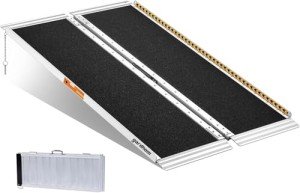5 Killer Quora Answers On Wheel Chair Ramps
A Comprehensive Guide to Wheelchair Ramps: Enhancing Accessibility for All
Availability is an essential right, yet lots of individuals with mobility difficulties face barriers daily. One crucial tool for overcoming these barriers is the wheelchair ramp. This article will explore the significance of wheelchair ramps, their various types, setup factors to consider, and upkeep pointers. In addition, we will deal with often asked questions to even more boost your understanding of wheelchair ramps.
What Are Wheelchair Ramps?
Wheelchair ramps tend surfaces that provide individuals utilizing wheelchairs (or those with restricted mobility) with a way to browse from one level to another. They are important in homes, public structures, and other centers to supply access to those who can not use stairs. By reducing accessibility obstacles, they empower users to move freely and individually.
Significance of Wheelchair Ramps
Wheelchair ramps serve numerous important functions, including:
- Increased Mobility: Ramps enable people to shift in between various elevations safely.
- Independence: They make it possible for wheelchair users to access locations without needing assistance.
- Compliance: Building codes and regulations typically mandate wheelchair access in public facilities.
- Security: Ramps decrease the threat of accidents connected with stair use.
Kinds Of Wheelchair Ramps
There are a number of types of wheelchair ramps, each created to satisfy distinct requirements. Below is a comparison of the most common types of wheelchair ramps:
| Type of Wheelchair Ramp | Description | Pros | Cons |
|---|---|---|---|
| Portable Ramps | Lightweight and simple to carry | Versatile; ideal for temporary access | Less stable than long-term ramps |
| Repaired Ramps | Irreversible installations | Adjustable to fit specific areas | Requires professional installation |
| Foldable wheel chair ramps | Compact and can be folded for storage | Easy to bring, versatile | Limited in length and angle |
| Limit Ramps | Brief ramps for door limits | Hassle-free for little height distinctions | Typically not appropriate for larger elevations |
| Modular Ramps | Modular style with adjustable areas | Extremely personalized; can be broadened | Can be pricey; complex installation |
| Scooter Ramps | Designed for scooters particularly | Accommodate much heavier devices | Not always appropriate for wheelchairs |
Features to Consider
When choosing a wheelchair ramp, the following features should be taken into account:
- Weight Capacity: Ensure the ramp can support the weight of the user plus any devices.
- Slope Ratio: The Americans with Disabilities Act (ADA) suggests a 1:12 slope for manual wheelchairs.
- Material: Common materials consist of aluminum, wood, and rubber, each with its benefits and drawbacks.
- Surface area Texture: A non-slip surface is essential for security, particularly in wet or icy conditions.
- Length and Width: Evaluate the area offered for the ramp and step appropriately.
Installation Considerations
Setting up a wheelchair ramp can be a simple or intricate process, depending on the kind of ramp chosen. Here are some essential aspects to think about throughout installation:

- Space Evaluation: Assess the location where the ramp will be set up to guarantee appropriate area for the ramp and its required slope.
- Local Regulations: Check regional codes and policies relating to wheelchair ramp setups to guarantee compliance.
- Surface area Preparation: The setup site ought to be leveled and cleared of challenges for a protected attachment if applicable.
- Expert Help: For fixed and modular ramps, consider hiring a certified specialist with experience in accessibility adjustments to ensure security and efficacy.
Maintenance of Wheelchair Ramps
Ensuring a wheelchair ramp stays in good condition is important for safety. Here are some upkeep ideas:
- Regular Inspection: Check for indications of wear, damage, or instability routinely.
- Cleaning: Keep the ramp surface area clear of debris, ice, and snow, specifically in winter season.
- Repair work: Address any issues immediately, such as loose screws or harmed surface areas.
- Upkeep: Repaint or reseal wood ramps to safeguard versus weather damage, and lube depend upon foldable ramps.
Regularly Asked Questions (FAQ)
What is the maximum slope for a wheelchair ramp?
The ADA recommends an optimum slope ratio of 1:12 for wheelchairs, meaning for each inch of height, there need to be at least 12 inches of ramp run.
Can I utilize a portable ramp for a long-term setup?
Portable ramps are designed for temporary usage. If an irreversible setup is required, consider purchasing a fixed ramp for safety and stability.
How do I understand which ramp is best for me?
Evaluate your requirements, consisting of the type of wheelchair used, the area where the ramp will be installed, and your budget plan. Consulting with a professional in ease of access can likewise supply useful insights.
Are wheelchair ramps appropriate for scooters?
Yes, numerous ramps are created to accommodate scooters, but guarantee the weight capability and measurements fit the particular scooter model.
Is a structure permit needed for ramp installation?
Depending upon local building regulations, an authorization may be required to set up a wheelchair ramp. It’s essential to validate with regional authorities before starting any installation work.
Wheelchair ramps are a crucial element of ease of access, enabling individuals with mobility challenges to navigate their environments safely and separately. Comprehending the kinds of ramps readily available, their functions, and appropriate setup and upkeep standards is important for guaranteeing the security and efficacy of these necessary tools.
By focusing on ease of access and including solutions like wheelchair ramps into homes and public spaces, society can work towards a future where everybody can enjoy the liberty of motion without barriers. For further concerns or help, think about reaching out to accessibility experts and resources tailored to particular requirements.


